
views
Splitting Rent with a Partner Based on Income

Have an honest conversation about rent and expenses with your partner. Money can be a sensitive topic for couples, but it's important to be open and honest if you don't feel like you can afford to split rent evenly with your partner. Ask your partner when a good time to talk is and sit down with them to try and work out an agreement that is fair for both of you. If you want to bring this up, you could say something like: "I have been looking at my expenses, and to be honest if I pay half the rent every month I'm going to be struggling to pay my other bills. Would you be willing to consider splitting the rent in a ratio according to our salaries so I'm not spending more than 30% of mine on rent?"
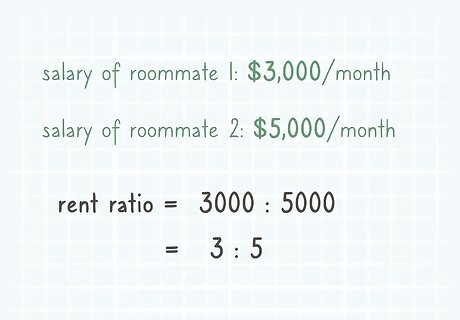
Split rent in a ratio proportionate to income if you make very different salaries. This method works well for couples who cohabit and want to share expenses but have significantly different incomes. Have an honest conversation about money and expenses to determine if you both agree that paying rent in a ratio equal to your individual incomes makes sense. A good rule of thumb is to not pay more than 30% of your monthly income towards rent. If you divide the rent in half, and the number is more than 30% of one partner’s monthly salary, then this method might be a good choice for you to split expenses fairly. If your monthly salaries are relatively close, then it might be best to just split rent 50/50. One partner can always agree to pay for more of the other household expenses, such as utilities or groceries, if they make slightly more than the other.
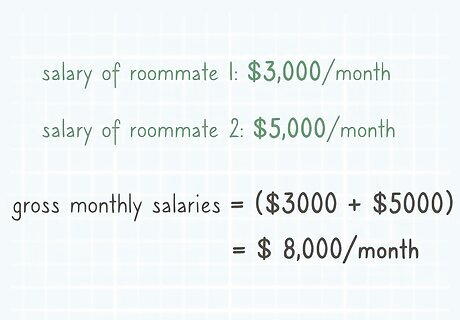
Add together your gross monthly salaries to get the total household income. Add together the amount of money each partner makes every month before taxes. You will use this number to help determine a fair way to split the rent based on each of your incomes. For example, if you make $3000 a month and your partner makes $5000 a month, then the total household income would be $8000 a month.
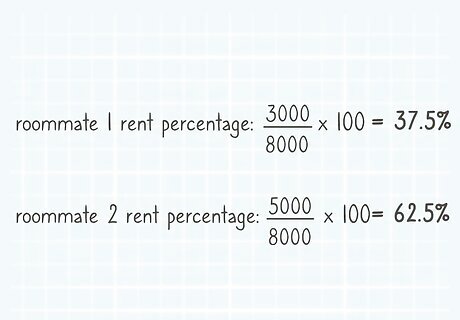
Divide each of your salaries by the combined total to get a percentage. Divide your income by the total household income to get a decimal point, then multiply the decimal point by 100 to get your percentage of the combined total. Subtract that percentage from 100 to get your partner’s percentage. For example, if you make $3000 a month, and the total combined household income is $8000, then divide 3000 by 8000 to get 0.375. Multiply that by 100 to get 37.5%. Subtract 37.5 from 100 to get your partner’s percentage of the total income, which would be 62.5% in this case.
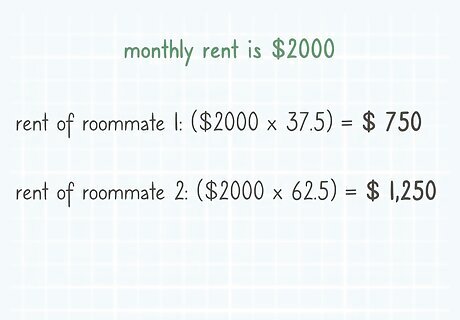
Pay a portion of the rent based on your portion of the total income. Multiply the monthly rent by the percentage of the monthly income you earn in decimal form. You pay this much of the monthly rent and your partner pays the rest.Tip: Keep in mind that you can use this number as a guideline to produce something that works for both of you. Consider other factors and expenses to decide what is fair. For instance, if you are debt-free and your partner has monthly student loan payments, you might agree to pay a higher share of the rent since they have other expenses that you don’t. For example, if you make 37.5% of the total income, and the monthly rent is $2000, multiply 2000 by 0.375 to get 750. You would pay $750 a month and your partner would pay $1251.
Dividing Rent Based on Square Footage

Have an open conversation with your roommates about splitting rent. Sit down with all of your roommates so you can talk about the best way to split rent. Everyone will be able to provide their input this way and you can come to an agreement that everyone feels is fair. You can do this ahead of time if you haven't yet moved in with your roommates yet or you can ask your current roommates to sit down and reevaluate how you are currently dividing the rent if you feel like something isn't fair. To bring this up with your roommates, you could say something like: "Hey guys, I would like to sit down with everyone and talk about our rent. Since some of the rooms are not as big as the others, what do you guys think about calculating a price for each room based on size?"
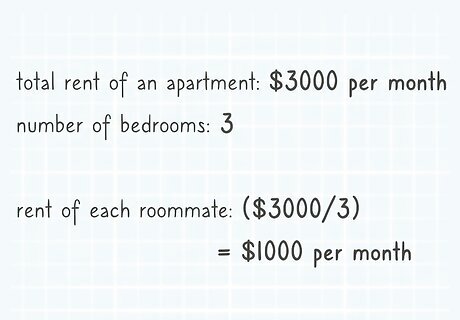
Divide rent evenly if the rooms are all about the same size. This is the simplest way to split rent with your roommates. Simply divide the total cost of rent by the number of rooms and have each roommate pay that amount if you all agree that the rooms are of equal size and value.Tip: Even though all the rooms may be the same size, sometimes certain rooms are more desirable than others. For instance, one room may have no windows, while another room has great natural lighting and a view. Always talk with your roommates and come to an agreement about how to choose rooms fairly or decide if one person will pay a higher amount for better features. For example, if the total rent of an apartment is $3000 a month and there are 3 bedrooms, then each roommate has to pay $1000 a month.

Find the square footage of each room if they are significantly different in size. Measure the width and length of each roommate’s private spaces in feet and multiply them together to get the square footage of each room. Include closets, private bathrooms, and any other spaces that the roommate won’t share with anyone else in the house. For example, if a room is 10x10 feet and has a 3x3 foot walk-in closet, then the total square footage for that room would be 109 square feet.
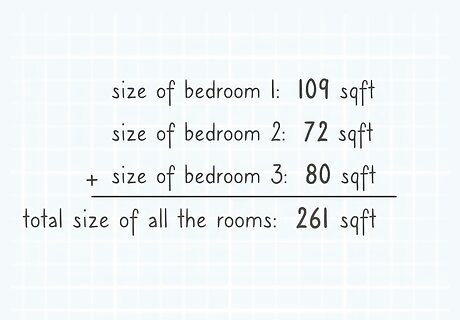
Add up the square footage for all the rooms. Find the total space of the bedrooms in the house by adding the square footage of each bedroom together. You will use this number to calculate the percentage of rent that corresponds to each room based on its size. For example, if 1 bedroom has a square footage of 109 feet, another is 72 square feet, and the last bedroom is 80 square feet, then the total square footage of all the bedrooms would be 261 square feet.
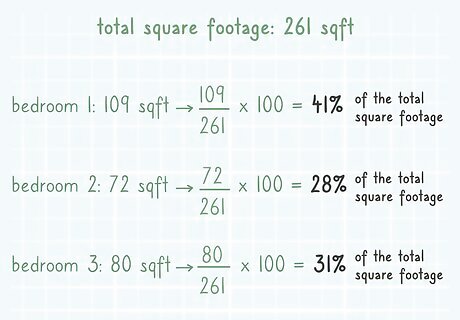
Divide the square footage of each room by the total to get a percent. Calculate the percentage of the total square footage for each room by dividing each room’s square footage by the total you got for all the bedrooms. This will give you the percentage of the rent that corresponds to each room based on how big it is. For example, if the total space of the bedrooms in the house is 261 square feet, then divide the square footage of each bedroom by this number to get the percentage of rent for that room. In a 3 bedroom house, a bedroom that is 109 square feet would be 41% of the total square footage, a bedroom that is 72 square feet would be 28% of the total square footage, and a bedroom that is 80 square feet would be 31% of the total square footage.
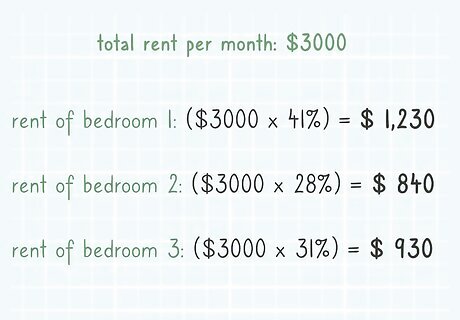
Have each roommate pay a corresponding percent of the rent. Use the percentages you calculated for each room to divide the rent. Multiply the rent by each percentage in the form of a decimal to get the exact amount each roommate needs to pay for their room. For example, if the total rent is $3000, and you determined that roommate number 1 needs to pay 41% of the rent based on the size of their room, then multiply $3000 by 0.41 to get the portion of the rent that they have to pay. In this case, roommate number 1 has to pay $1,230 for their room. There are lots of rent calculator tools online that you can use to help you figure out how to split rent if math isn’t your strong suite. All you have to do is plug in the numbers and the calculator will tell you how much rent each person has to pay.
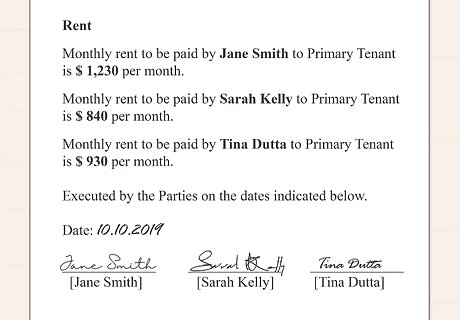
Sign an agreement about rent between roommates to avoid conflicts. Write down the amount of the rent that each roommate agrees to pay and have everyone sign it. This will give you something to refer to if any disagreements about what each roommate has to pay arise in the future. This doesn’t need to be anything complicated. Simply write down some basic details like the date, the address of the property, the total monthly rent for the house or apartment, and what each roommate has agreed to pay. For example, “Jeremy agrees to pay $1,230 or 41% of the total monthly rent of $3000.” You could look for a legal template online for such an agreement to help you make it more formal if you want to. However, this isn't required.

















Comments
0 comment